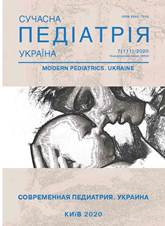Modern solution to the problem of pain relief in newborns with necrotizing enterocolitis
Keywords:
pain, newborns, analgesia, necrotizing enterocolitisAbstract
To date, there is no doubt that newborns feel pain. They have short-term and long-term effects of pain, which include disorders of neurological and behavioral development. The perception of pain requires the functioning of the anatomical structures through which the impulse enters the central nervous system, and the neuroendocrine system, which provides the body's response to pain. Diagnosis of pain in newborns is made by assessing the behavioral, physiological and hormonal responses that occur in response to a painful stimulus. Among the three most common pain assessment scales, the PIPP scale is used more often, one of the significant advantages of which is taking into account the degree of maturity and the term of birth of the child, together with the assessment of behavioral responses, physiological parameters (heart rate, oxygen saturation ), the work of facial muscles. Modern strategies for the treatment of acute pain are based on the concept of multimodal analgesia, the main idea of which is to increase the effectiveness of analgesics while reducing the incidence of side effects, using drugs of different groups with different points of application. Interventions to control neonatal pain can be both non-pharmacological and pharmacological. In the case of a relatively stable condition of a patient with necrotizing enterocolitis, the preoperative stage of anesthetic management should be focused on assessing and adjusting the respiratory, circulatory and metabolic status, as well as on the assessment and correction of current hematological and coagulation disorders as an integral part of the above actions. In the case of suspected or therapeutic necrotizing enterocolitis, the main therapeutic interventions should be aimed at creating conditions for the so-called «rest» for the intestine, its decompression and the appointment of broad-spectrum antibiotics. Therefore, anesthetic management of necrotizing enterocolitis is the need to continue the current intensive care and resuscitation, which is especially useful in cases where a critically ill newborn needs vital rescue surgery.
References
Anand KJ, International Evidence-Based Group for Neonatal Pain. (2001). Consensus statement for the prevention and management of pain in the newborn. Arch Pediatr Adolesc Med. 155 (2): 173-180. https://doi.org/10.1001/archpedi.155.2.173; PMid:11177093
Anand KJS, Eriksson M, Boyle EM et al. (2017). EUROPAIN survey working group of the NeoOpioid Consortium. Assessment of continuous pain in newborns admitted to NICUs in 18 European countries. Acta Paediatr. 106 (8): 1248-1259. https://doi.org/10.1111/apa.13810; PMid:28257153
Aydede M. (2019, Aug 13). Does the IASP definition of pain need updating? Pain Rep. 4 (5): e777. https://doi.org/10.1097/PR9.0000000000000777; PMid:31875184 PMCid:PMC6882577
Boyle EM, Bradshaw J, Blake KI. (2018, Jan). Persistent pain in neonates: challenges in assessment without the aid of a clinical tool. Acta Paediatr. 107 (1): 63-67. https://doi.org/10.1111/apa.14081; PMid:28925559
Lago P, Garetti E, Merazzi D, Pieragostini L, Ancora G, Pirelli A, Bellieni CV et al. (2009). Guidelines for procedural pain in the newborn. Acta Paediatr. 98 (6): 932-939. https://doi.org/10.1111/j.1651-2227.2009.01291.x; PMid:19484828 PMCid:PMC2688676
Lee GY, Yamada J, Kyololo O, Shorkey A, Stevens B. (2014). Pediatric clinical practice guidelines for acute procedural pain: a systematic review. Pediatrics. 133 (3): 500-515. https://doi.org/10.1542/peds.2013-2744; PMid:24488733
Loeser JD, Treede RD. (2008). The Kyoto protocol of IASP Basic Pain Terminology. Pain. 137 (3): 473-477. Epub 2008 Jun 25. https://doi.org/10.1016/j.pain.2008.04.025; PMid:18583048
Ranger M, Chau CM, Garg A et al. (2013). Neonatal pain-related stress predicts cortical thickness at age 7 years in children born very preterm. PLoS One. 8 (10): e76702. https://doi.org/10.1371/journal.pone.0076702; PMid:24204657 PMCid:PMC3800011
Ranger M, Synnes AR, Vinall J, Grunau RE. (2014). Internalizing behaviours in school-age children born very preterm are predicted by neonatal pain and morphine exposure. Eur J Pain. 18 (6): 844-852. https://doi.org/10.1002/j.1532-2149.2013.00431.x; PMid:24318537 PMCid:PMC4016156
Witt N, Coynor S, Edwards C, Bradshaw H. (2016). A Guide to Pain Assessment and Management in the Neonate. Curr Emerg Hosp Med Rep. 4: 1-10. https://doi.org/10.1007/s40138-016-0089-y; PMid:27073748 PMCid:PMC4819510
Downloads
Published
Issue
Section
License
The policy of the Journal “MODERN PEDIATRICS. UKRAINE” is compatible with the vast majority of funders' of open access and self-archiving policies. The journal provides immediate open access route being convinced that everyone – not only scientists - can benefit from research results, and publishes articles exclusively under open access distribution, with a Creative Commons Attribution-Noncommercial 4.0 international license (СС BY-NC).
Authors transfer the copyright to the Journal “MODERN PEDIATRICS. UKRAINE” when the manuscript is accepted for publication. Authors declare that this manuscript has not been published nor is under simultaneous consideration for publication elsewhere. After publication, the articles become freely available on-line to the public.
Readers have the right to use, distribute, and reproduce articles in any medium, provided the articles and the journal are properly cited.
The use of published materials for commercial purposes is strongly prohibited.

